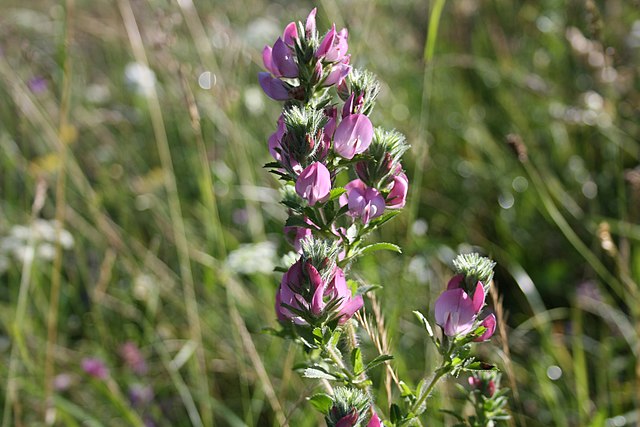 |  |  |   |   |
 |  |
Field restharrow is a perennial plant, 30-50 cm tall (rarely <80 cm). It has a distinct, long, woody, weakly branched taproot, which transitions upwards into a short, multi-headed rhizome dark brown or black in color, white at the point of fracture.
Stems are several, erect, rarely raised, branched, hairy, more often with hooks and woody at the base. Often the stems are violet-red in color, with small side branches, often they also have hooks at the end.
Leaves with large leaflets, growing on the petiole, arranged alternately, trifoliate (lower and middle) and simple (upper). The triple leaves are elongated elliptic (1.5-3 cm long), with sharply serrated leaf edges, hairy on both sides, slightly sticky. Flowers on short peduncles, placed two by two in leaf axils, at the ends of stems and branches, forming dense spike-like inflorescences. Flowers bright pink or pinkish white (15-22mm long). The top petal is larger than the side two. The plant blooms in June-August. Fruit a pod (~7mm long), rounded elliptic or ovoid, hairy. The seeds are round or slightly kidney-shaped, dark brown or light brown, ripen in July-September.
Dried roots, both from wild plants and cultivated plants, are used for medicinal purposes. Roots are collected in autumn (September-October). The whole plant is dug up, cleaned from the soil, the surface part is cut off and the roots are washed in cold, running water. The roots are twisted within two days, then dried within 7 days in forced dryers at a temperature not exceeding 60C.
The drug is dried whole or halved roots, up to 40 cm long and 0.5-2.5 cm wide. The roots are very hard, woody, they have a cylindrical, often angular or compressed shape, the surface is rough, in some places the upper layer has bounced off the root. The fracture site is fibrous. The color of the rhizome is light brown, when broken it is yellow-white. The smell is peculiar, the taste is bittersweet, slightly astringent.
Many biologically active substances, such as glycosides (ononid and ononin, astralgin), saponins (onoceral), flavonoids, tannins and resins, essential oil and vegetable fats, organic acids, as well as proteins, starch, mucilage and up to 10 % mineral salts. In addition, the root of the Field restharrow contains about 0.3% of the dibasic tetracyclic triterpene alcohol - onocerin, as well as macro and micro elements (boron, iodine, lead, chromium, strontium, molybdenum, iron, zinc, nickel, magnesium, copper, selenium, calcium , manganese, vanadium, potassium, aluminum).
Medicinal significance
The plant contains a medically valuable flavonoid - macovine, which belongs to the group of pterocaprans, which have fungicidal properties.
The pharmacological properties of the Field restharrow are based mainly on the flavonoid ononin contained in it. Preparations of the roots of the Field restharrow cause a temporary decrease in arterial pressure, increase diuresis, reduce the fragility of capillaries and reduce bleeding time, besides, it does not affect blood clotting.
In addition, the roots of the Field restharrow have anti-hemorrhagic, diuretic, choleretic, analgesic, anti-inflammatory and hemostatic effects.
Preparations of the roots of Field restharrow have a diuretic, hypotensive, cardiotonic, bleeding-stopping, capillary-strengthening and anti-inflammatory effect. The plant has softening properties, increases the tone of the intestinal walls and removes sphincter spasms, activates the secretory activity of internal glands, improves metabolism.
A poultice decoction is used to treat hemorrhoids, rectal fissures, post-dysenteric and protogenic constipation, as well as atonic and spastic constipation in patients who are in bed for a long time, after injuries and operations.
After using the preparation of the Field restharrow , the tone of the intestinal walls will increase, the blood flow in the hemorrhoidal veins will decrease, and the edema of the hemorrhoidal nodes will decrease. And the act of defecation is facilitated. The anti-inflammatory ability of the plant and its ability to prevent blood clots are of great importance. In this way, the Field restharrow is used to treat thrombophlebitis, varicose phlebothrombosis, varicose veins of the legs, as a means that reduces the permeability of blood vessels and blood clotting inside the blood vessels.
Externally, Field restharrow dissolved in cold water is used as a compress, inflammation of hemorrhoidal nodes and treatment of trophic ulcers in the thighs.
In folk medicine, decoction and infusion of leaves are most often used. Treatment with Field restharrow promotes rapid relief from constipation and normalization of output, significantly improving well-being and stops bleeding of hemorrhoidal nodes within 7-10 days.
Concentrations or decoctions are also used as bleeding agents in case of furunculosis, pimples, skin rashes, as in inflammatory diseases of the urinary tract, kidneys and bladder. For the prevention of kidney stones, gout and rheumatism. The shoots are used in exactly the same way as the roots.
